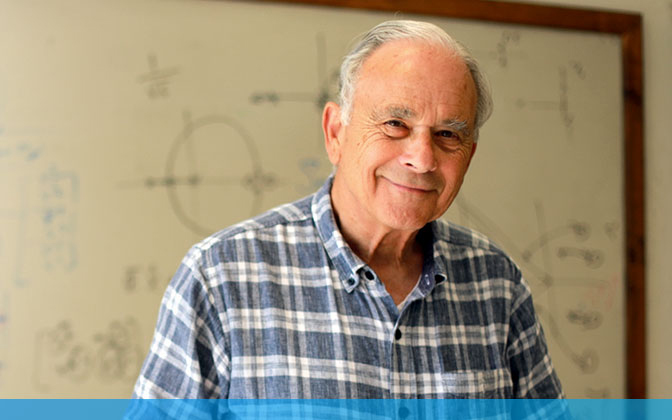On the week marking the 50th anniversary of the moon landing, the distinguished professor of mechanical and aerospace engineering reflects on his early career and influences during the Space Age.
Nothing against the brave astronauts, but for UCLA Samueli Professor Jason Speyer, whose distinguished career in aerospace spans nearly 60 years, the larger story of the Apollo missions includes the many engineers who designed the spacecraft and its systems.
“I personally believe that engineers should get more credit for what they did,” he said. “We talk about the individuals that landed on the moon. What about all of the engineers that made it possible?”
Speyer, still active in teaching and research, can talk in great detail about many of those engineers who played outsized roles during the Apollo missions to the moon. That’s because they were his mentors and colleagues.
For example, Charles Stark Draper the head of MIT’s Instrumentation Laboratory, sparked Speyer’s lifelong interest in control theory after he took a class introduced into the curriculum by Draper. Known as the “father of inertial navigation,” Draper developed the theory and technology that spacecraft and airplanes use to determine their position and heading.
Speyer’s Ph.D. supervisor at Harvard, Arthur Bryson, is a pioneer in control theory and its applications. For spaceflight, this means incorporating real world observations into algorithms that computers can work with to solve problems. Speyer notes he’s still in regular contact with Bryson, now an emeritus professor at Stanford.
Speyer also worked with Richard “Dick” Battin and J. Halcombe “Hal” Laning, who were both also part of the Instrumentation Lab. They led the development of what would become the Apollo Guidance, Navigation, and Control System, which was implemented in the Apollo Computer. And this is where Speyer’s own connection to the Apollo missions start.
But for some background, reverse course and go back a few years.
Speyer was an undergraduate at MIT in the late 1950s at the dawn of Space Age which officially began when the Soviet Union launched Sputnik into orbit.
“When I graduated, it was called the Department of Aeronautics and Astronautics,” he said. “When I went in, it was the Department of Aeronautics. So it had an impact.”
Following his bachelor’s degree, Speyer spent one year at Boeing in Seattle before returning to Massachusetts to work at Raytheon, which was contracted by the Instrumentation Laboratory to work on a guidance computer for the Apollo mission. Around the same time, he also began graduate studies in applied mathematics at Harvard.
One of his papers stemming from his work at Raytheon was, “Optimal Measurement and Velocity Correction Programs for Midcourse Guidance,” which he co-wrote with colleague Walter Denham and was published in AIAA Journal in 1964.
The Apollo Command Module needed to get to the moon and back. And the astronauts aboard needed to know where they were, and where they were headed. Their solution to this navigation problem was based on the same celestial navigation tool that sailors had used for hundreds of years – a sextant.
“They needed an autonomous navigation system,” Speyer said. “The idea was that the Russians might jam the navigation system that they planned to use on the Apollo, because they had to communicate with the ground. And if they did that, they had to have something that the astronauts could use to know where they were. This is for the trip from the Earth to the moon, and then from the moon and back.”
“The basic device they used was the sextant that made angle measurements,” he said. “They take angle measurements of the stars and the horizons. They had a field of stars that the astronauts should look at, and either the near or far horizons of the Earth or the moon. “My job was to develop the numerical code that produced the optimal angle sequence between the Earth and moon that minimizes the position and velocity uncertainty at the moon.”
The angle information was then fed into the Apollo Guidance Computer. In fact, the optimal angle sequence that he and colleagues developed was first used in Apollo 8 in 1968, which was the first to orbit the moon. It was then used in Apollo missions including Apollo 11, when astronauts landed on the moon in July 1969.
But Speyer said he didn’t find out that the system was actually used in Apollo until after the moon landing.
Today, Speyer is still working to solve challenges in deep space spacecraft navigation. Only instead of stars, he’s been developing the use of pulsars, rapidly rotating stars that send out x-rays several times a second, as the celestial guideposts.
Jason Speyer is the Ronald and Valerie Sugar Professor of Engineering at UCLA Samueli. He holds faculty appointments in mechanical and aerospace engineering, and electrical and computer engineering. He has received numerous honors for his contributions to aerospace engineering including the Richard E. Bellman Control Heritage Award from the American Automatic Control Council in 2016, the American Institute of Aeronautics and Astronautics’ Aerospace Guidance, Navigation, and Control Award in 2012, election to the National Academy of Engineering in 2005, and the Third Millennium Medal from the Institute of Electrical and Electronics Engineers in 2001, and He is a fellow of IEEE and AIAA. Speyer joined the UCLA Samueli faculty in 1990 after nearly 14 years at the University of Texas at Austin.
By UCLA Samueli Newsroom

